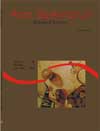<b>Parasitological and hematological analysis of Nile tilapia <em>Oreochromis niloticus</em> Linnaeus, 1757 from Guarapiranga reservoir, São Paulo State, Brazil</b> - DOI: 10.4025/actascibiolsci.v27i3.1334
Abstract
A total of 206 adult specimens of tilapia, Oreochromis niloticus, were collected from the Guarapiranga Reservoir, Sao Paulo, from August 1996 to April 1998, to relate their health condition with parasite infestation. Hematocrits and the differential leukocyte counts were analyzed. Scrapings of skin and gills were performed and this last removed and fixed for the identification of monogeneans. In the gills, Trichodina, Ichthyophtirius multifiliis, Cryptobia, amoebas and monogeneans (Cichlidogyrus sp.) were found, and in the skin, Trichodina, Cryptobia and Henneguya. The prevalence of some parasites seemed to be associated with water temperature and the level of dissolved oxygen. The hematocrit and leukocyte cells percentage showed little variation during the sampling period. Only basophils demonstrated a significant difference between monthly mean values. The eosinophil percentage was higher in fish parasitized with I. multifiliis and Cichlidogyrus sp. and in non-parasitized animals. There was no detection of fish mortality. It could be concluded that the fish were in good health even though the condition of the Reservoir water was not idealDownloads
Download data is not yet available.
Published
2008-03-26
How to Cite
Ranzani-Paiva, M. J. T., Felizardo, N. N., & Luque, J. L. (2008). <b>Parasitological and hematological analysis of Nile tilapia <em>Oreochromis niloticus</em> Linnaeus, 1757 from Guarapiranga reservoir, São Paulo State, Brazil</b> - DOI: 10.4025/actascibiolsci.v27i3.1334. Acta Scientiarum. Biological Sciences, 27(3), 231-237. https://doi.org/10.4025/actascibiolsci.v27i3.1334
Issue
Section
Ecology and Limnology
DECLARATION OF ORIGINALITY AND COPYRIGHTS
I Declare that current article is original and has not been submitted for publication, in part or in whole, to any other national or international journal.
The copyrights belong exclusively to the authors. Published content is licensed under Creative Commons Attribution 4.0 (CC BY 4.0) guidelines, which allows sharing (copy and distribution of the material in any medium or format) and adaptation (remix, transform, and build upon the material) for any purpose, even commercially, under the terms of attribution.
Read this link for further information on how to use CC BY 4.0 properly.
0.6
2019CiteScore
31st percentile
Powered by 

0.6
2019CiteScore
31st percentile
Powered by 











1.png)




3.png)













